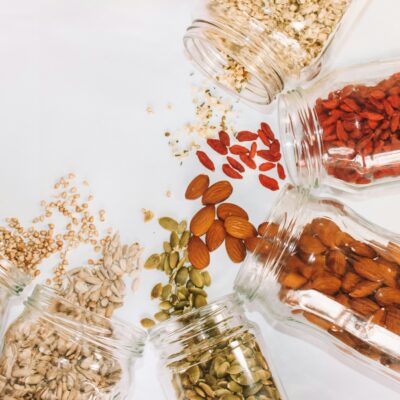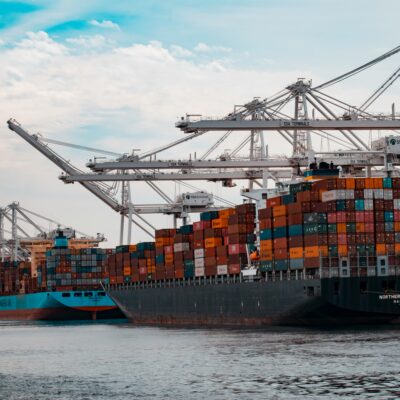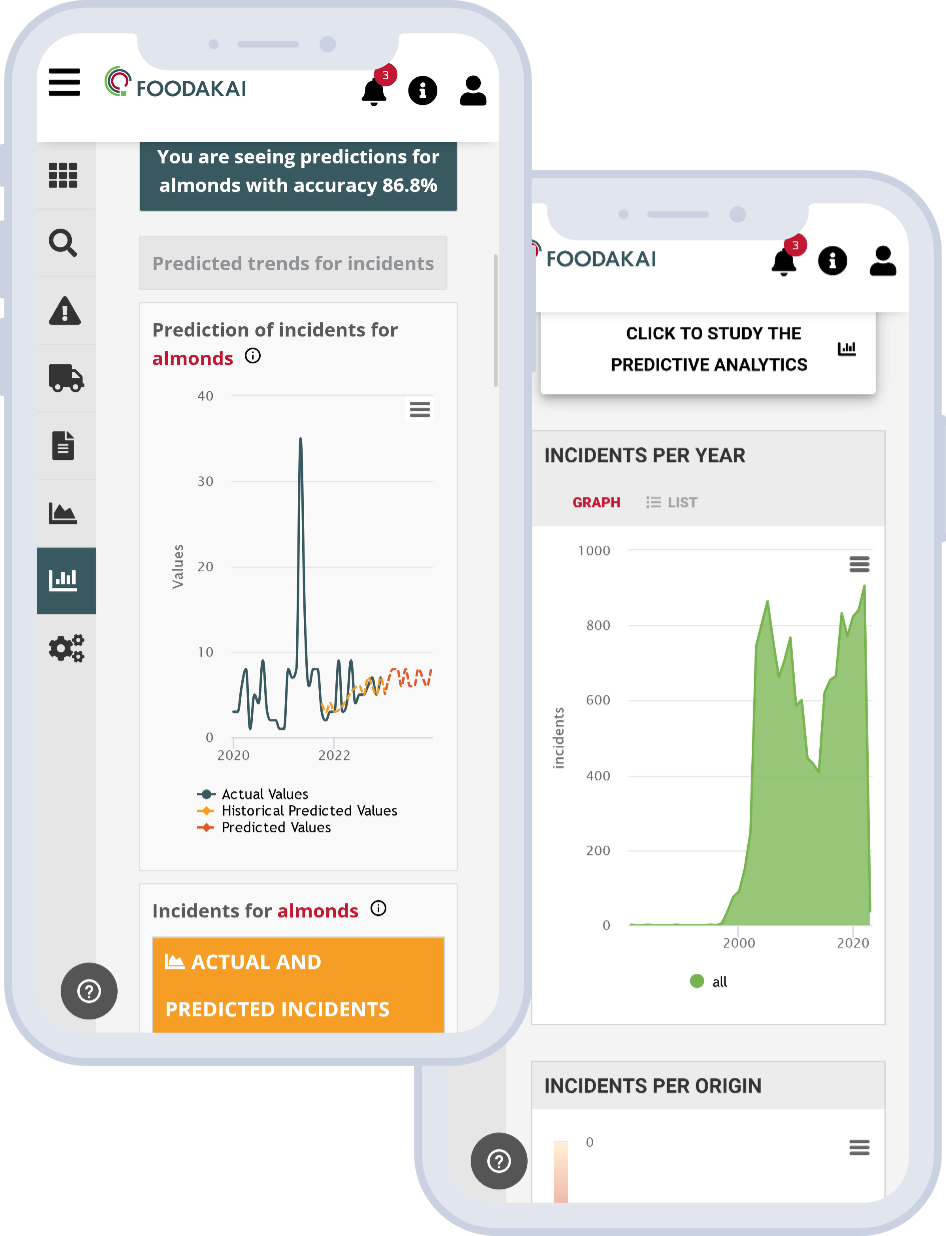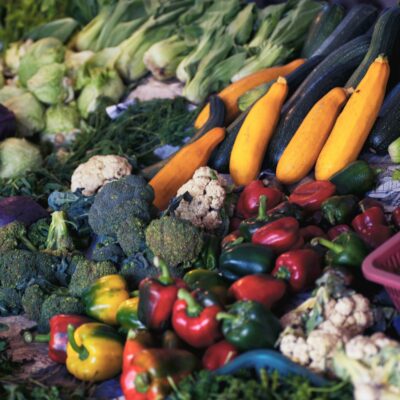
Monthly Forecasts Review: August
Welcome back to another edition of our Monthly Forecasts Review, the blog series where we review our monthly incident forecasts by looking closely at their performance over the actual recorded incidents for the previous month.
After taking a break in August, we are back to examine incident trends forecasts for ten key food categories and hazard trends forecasts for the top Biological, Chemical, Foreign Bodies, Allergens Hazards as well as Food Fraud. This time we will be looking at how August's forecasting faired against the recorded incident numbers.
How is the performance of the forecasts reviewed?
To examine the performance of forecasts we compare the forecasted incidents trend for each food product category, hazard, and risk category from FOODAKAI with the actual number of recorded incidents for that month.
FOODAKAI employs trend forecasting models that utilize different sources to predict future incidents and trends, taking advantage of multiple factors (more than 250 distinct factors) in order to produce robust generalized models and accurate predictions and promote proactivity in food & beverage companies.
For our previous edition ─ the June report, read here.
Key Food Categories Forecasts Review
Firstly, let’s start with the overall incidents trend forecasts in 10 Key Food Categories for August.
FOODAKAI successfully anticipated the incidents trend in 8 out of the 10 key food categories: Cocoa, Coffee & Tea, Fruits & Vegetables, Dairy Products, Poultry & Poultry Meat Products, Herbs & Spices, Confectionary, Fats & Oils, and Meat & Meat products. The forecasts for the Cereals & Bakery and Nuts & Seeds categories were not successful.
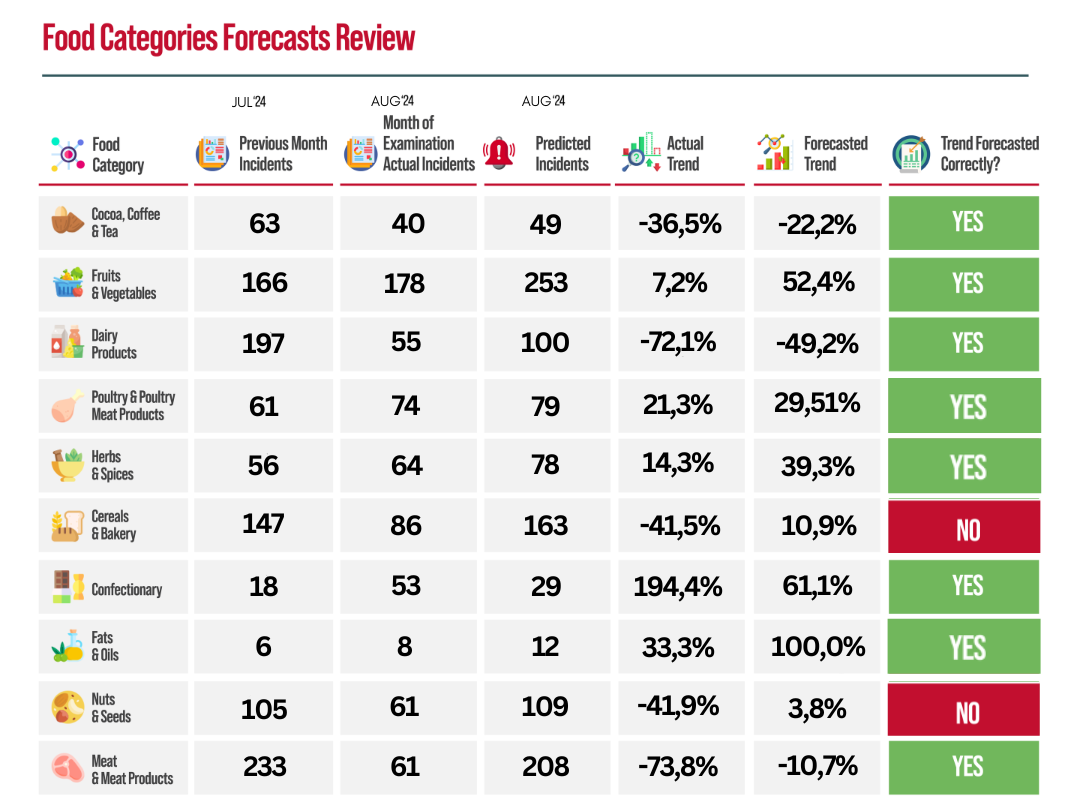
Highlights:
- In the Cocoa, Coffee & Tea, and Poultry & Poultry Meat products category, FOODAKAI forecasted the trend with great accuracy with only a small difference in the percentages of trend value.
- In the Fruits & Vegetables food category, despite the fact the platform forecasted the decreasing trends successfully, the volume of the data available could have produced an even better forecasting.
- In the Dairy products category, while the platform correctly forecasted the decreasing trend, it projected a lower decrease (-49,02%) than the actual (-72.1%).
- In the Herbs & Spices product category, the platform correctly forecasted the increase with a slight difference in the percentages.
- For both the Confectionary and Fats and Oils product categories, FOODAKAI forecasted an increase in the number of incidents but by projecting a lower-than-expected increase for the first category and higher than the actual number of incidents for the second. In the case of Fats & Oils, this forecasting can be attributed to the lack of data in the category for robust predictions.
- For the Cereals & Bakery products as well as the Nuts & Seeds and, the platform didn’t anticipate the trend successfully. In both cases, tuning of the forecasting model will enable the platform to produce more accurate forecasts in the future.
- In the Meat & Meat Products category, the forecasting model correctly forecasted a decrease, although lower than the actual.
Hazard & Risk Categories Forecasts Review Now, let’s review the performance of the hazard & risk trend forecasts in comparison to the recorded number of incidents.
FOODAKAI managed to successfully forecast the incident trend in 4 out of the 5 Hazard and Risk types: Chemical, Biological, Allergens, and Foreign Bodies. It didn’t forecast the trend for Food Fraud incidents.
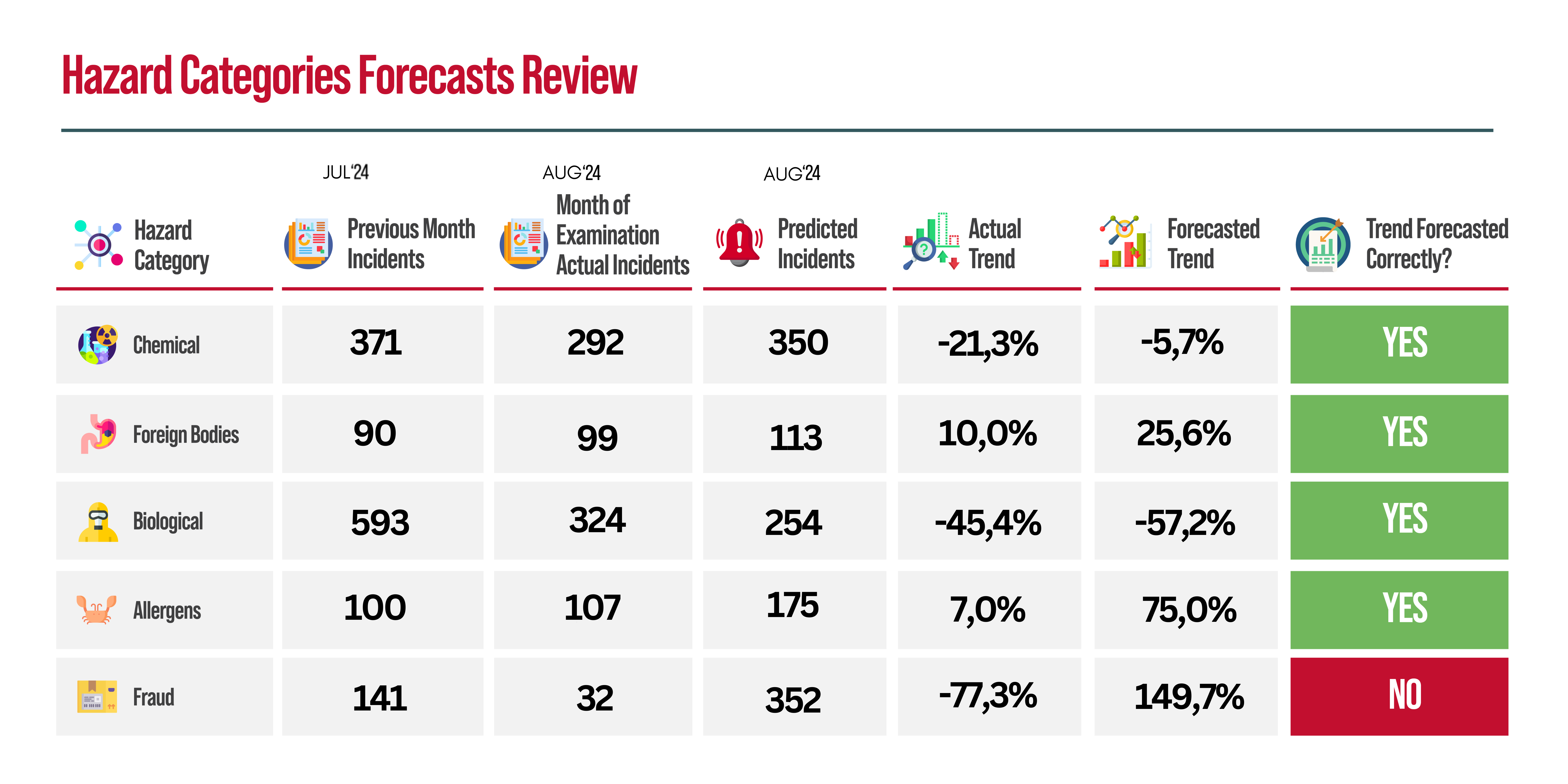
Highlights:
- For Chemical Hazards incidents, the platform anticipated a decreasing trend, although expecting a lower increase than the actual.
- For Biological Hazards & Foreign bodies incidents, FOODAKAI forecasted with exceptional accuracy the decreasing & increasing trends accordingly with only minor differences in the percentages from projected to actual values.
- In the Allergen Hazard type category, while FOODAKAIforecasted the increase successfully, it did so by anticipating a much larger increase than the actual.
- In the Food Fraud product category, the platform forecasted a large increase, rather than a decrease owing to the delay in the announcement of incidents that might have influenced the number of incidents and the forecast trend.
Chemical Hazards Forecasts Per Food Category
Finally, let’s dig deeper into the forecasted vs the actual trends for incidents associated with chemical hazards for these 10 Food Categories.
The platform forecasted the incident trends for chemical hazards in 7 out of the 10 food categories: Cocoa, Coffee & Tea, Dairy Products, Poultry & Poultry Meat Products, Herbs & Spices, Confectionary, Nuts & Seeds, and Meat & Meat products. For the Fruits & Vegetables, Cereals & Bakery, and Fats & Oils categories, the incident trend was not forecasted successfully.
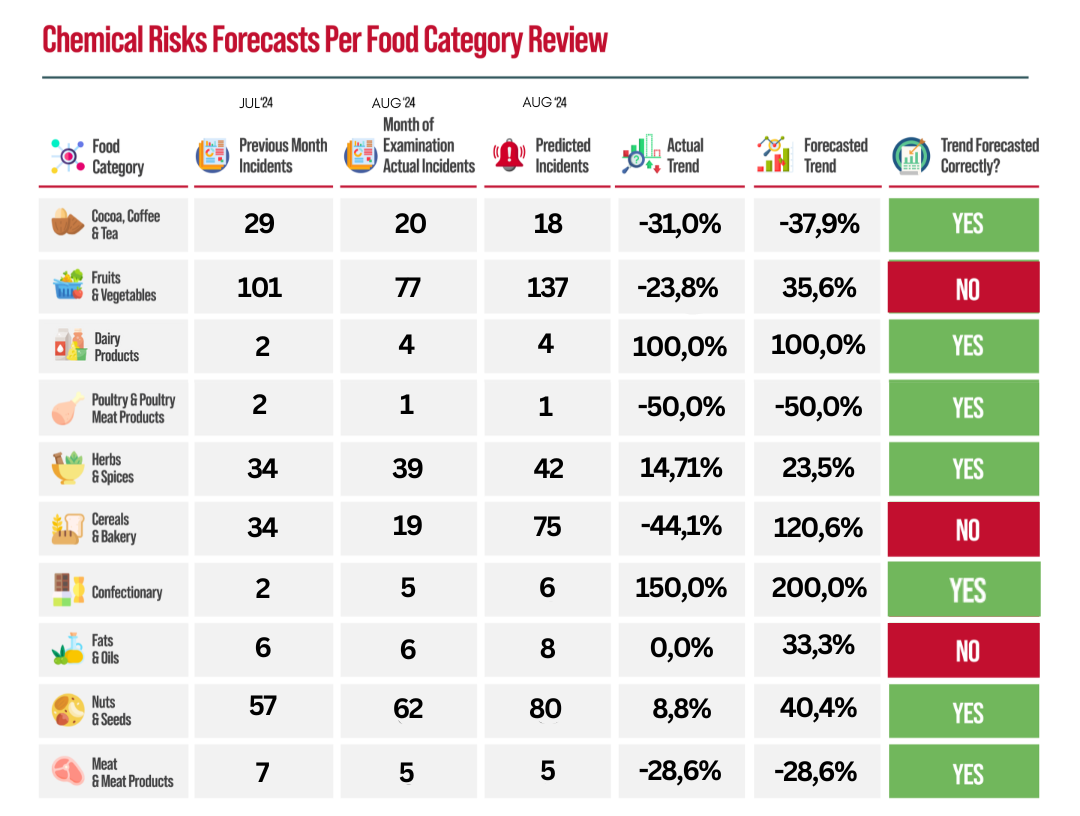
Highlights:
- For Chemical Hazards in Cocoa, Coffee & Tea, and Herbs & Spices the platform forecasted the increasing trend with exceptional accuracy.
- In the Fruits & Vegetables as well as Herbs & Spices product categories, FOODAKAI forecasted the decreasing trend successfully with only a slight difference in the percentages.
- For Chemical Hazards incidents in Dairy Products, Poultry & Poultry Meat Products, and Meat & Meat Products, FOODAKAI achieved 100% accurate forecasting.
- In both Fruit & Vegetables and Cereals & Bakery products the platform forecasted an increase while in both cases a decrease in the number of incidents was recorded.
- In the Confectionary and Nuts & Seeds product categories, the increasing trend was validated, but with a large difference in the values between the forecasted and actual trends.
- In the Fats & Oils product category, the platform forecasted an increase, while the was no increase or decrease in the number of incidents from the previous month.
In today’s evolving food safety landscape, it is crucial for food and beverage companies to anticipate emerging risks in their products and supply chains. The use of predictive analytics and data-driven forecasting models, such as those provided by platforms like FOODAKAI, enables companies to proactively identify potential hazards and incidents before they occur.
By leveraging accurate forecasts for biological, chemical, allergen, and food fraud risks, businesses can strengthen their risk mitigation strategies, ensuring product safety, preventing costly recalls, and maintaining consumer trust. The ability to foresee risks is essential for building a resilient and future-proof food safety system.
Interested in seeing more forecasts? Access live forecasts here.
Want to learn more about how you can benefit from such forecasts, book a demo here.
Want to receive helpful food safety intelligence in your inbox?
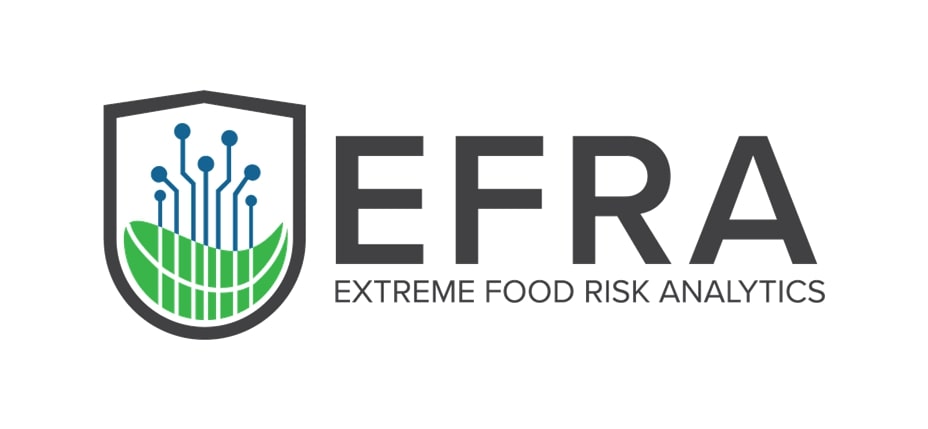 Funding for this research has been provided by the European Union’s Horizon Europe research and innovation programme EFRA (Grant Agreement Number 101093026). Funded by the European Union. Views and opinions expressed are however those of the author(s) only and do not necessarily reflect those of the European Union or European Commission-EU. Neither the European Union nor the granting authority can be held responsible for them.
Funding for this research has been provided by the European Union’s Horizon Europe research and innovation programme EFRA (Grant Agreement Number 101093026). Funded by the European Union. Views and opinions expressed are however those of the author(s) only and do not necessarily reflect those of the European Union or European Commission-EU. Neither the European Union nor the granting authority can be held responsible for them.


